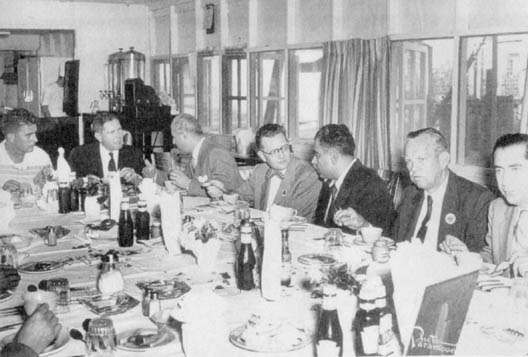
|
|
|
Notes from the Minefield Irene L. Gendzier
Hardback: Softback:
Illustration from the book: Left to right: Bill Helmann [sic], foreman; William Campbell, vice president, government relations, TAPLINE; Saleh al-As'ad, TAPLINE public relations officer; William R. Chandler. Second from right: Colonel William Eddy. (Photograph courtesy of William R. Chandler, fromer president, Trans-Arabian Pipeline Company.) From Part II Formative Years in the Evolution of U. S. Policy: 1944 - 1952, Chapter 5. The Foundations of U. S. Policy, PACLIFT, page 97 - 98: "The situation in Damascus was dramatically different. Given the economic ties between Syria and Lebanon, and the dependence of Lebanon's pipeline on Syrian approval, the resistance of the Syrlan regime to TAPLINE's concessionary offer became a major problem in Beirut. Syria signed an accord with TAPLINE on September 1, 1947, but parliamentary ratification was delayed for political and economic reasons. The regime was critical of U.S. policy in Palestine, and it wanted more favorable commercial terms from TAPLINE. But then U.S. oil executives were unwilling to bend on matters of profit, preferring instead to pressure President Quwwatly of Syria and Prime Minister Mardam indirectly through Saudi Arabia and Lebanon, as well as directly through TAPLINE's officers. When in 1948 it appeared that the Syrian negotiations might fail, preparations for construction in Syria, Lebanon, and Jordan ceased, only to continue exclusively in Saudi Arabia to assure the ARAMCO operation. In practice, the March 1949 military coup in Damascus solved the problem. Within two months, in the presence of William Owen, attorney with TAPLINE and ARAMCO and later TAPLINE's general counsel, and William A. Campbell of TAPLINE, the concession was approved, leading to the completion of construction at the Sidon end.13 Recent investigation of the circumstances surrounding the first military coup in Syrian postwar history indicates that CIA agents Miles Copeland and Stephen Meade, who acted as U.S. military attache in Damascus, were directly involved in the coup in which Syrian colonel Husni Za'im seized power. According to then former CIA agent Wilbur Eveland, the coup was carried out in order to obtain Syrian ratification of TAPLINE.14 Douglas Little writes that "Meade and Zaim completed planning for the coup in early 1949. On March 14, Zaim 'requested U.S. agents [to] provoke and abet internal disturbances which [are] essential for coup d'etat' or that U.S. funds be given him [for] this purpose as soon as possible."15 Assistant Secretary of State McGhee, according to the same source, put in an appearance in Damascus at a critical moment in the course of these events, "possibly to authorize U.S. support for Zaim" in addition to discussing settlement of Palestinian refugees in Syria. On March 30, the coup took place, followed by the arrest of the Syrian president and the prime minister and the suspension of the constitution. In less than a month, the new Syrian regime was involved in negotiations with Israel, planning for the resettlement of Palestinian refugees and, in mid May, approving the TAPLINE concession. With the end of the phase of Syrian resistance, TAPLINE and ARAMCO celebrated a banner year: 1950 was the year of the historic 50/50 profit-sharing agreement in Saudi Arabia, which was cause for grief in London and for increased demands for profit sharing in Beirut. But 1950 was also the year that oil flowed to the waiting tankers off the coast at Sidon on their way to Europe and North America. When completed, the pipeline allowed ARAMCO to avoid the sea route through the Gulf and the Suez Canal, a distance equivalent to some "7,200 miles of sea journey." The annual traffic "was the equivalent of sixty tankers in continuous operation from the Persian Gulf, via the Suez Canal, to the Mediterranean."16 In addition to the 1,069 miles of the Sidon-Saudi pipeline, TAPLINE built a communication system that linked Sidon as well as Beirut with Saudi Arabia." 13 According to Chandler [William Chandler, former Tapline prsident]i, when the future of the concession appeared uncertain in Damascus, construction continued in Saudi Arabia, "working westward toward Abu Hadriya, so that if a Syrian agreement was never obtained the line being built in Saudi Arabia would serve as part of the ARAMCO gathering system" (letter, Mar. 3, 1995). William Owen, attorney and later counsel for TAPLINE, reportedly had close relations with William Donovan of the OSS, according to William Chandler (telephone interview, Apr. 10, 1995). 14 Little, "Cold War and Covert Action," p. 55. In an interview with Wilbur Eveland in Boston, Oct. 27, 1988, the former CIA agent in the Middle East confirmed that the 1949 coup was carried out by Miles Copeland to obtain Syrian ratification of TAPLINE. 15 Little, "Cold War and Covert Action," p. 56. In a study on Bechtel by Laton McCartney, Friends in Higb Places, p. 115, the author cites unidentified State Department sources, as well as the U.S. minister to Saudi Arabia, J. Rives Childes, to the effect that a "multinational corporation" was involved in the Syrian coup. Suggestions that Bechtel may have played this role were denied by Bechtel officials, a position recently confirmed by William Chandler (telephone interview, Apr. 10 and Apr. 12, 1995) and by David Dodge (telephone interview, Apr. 22, 1995). 16 Daniel Yergin, The Prize, p. 427. The figure for the full length of the pipeline is taken from Chandler, letter, Mar. 3, 1995. |
|
 981126/bl |
|
